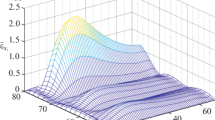Abstract
A specially planned experiment based on obtaining a required family of estimates of supporting integral curves (approximately described in a given finite system of base functions) is used to solve a problem of active identification of a dynamic object, which corresponds to an a priori unknown differential equation. In view of the fact that experimental data may contain fluctuation and singular interference, a method is developed for optimal unbiased estimation of linear quantitative characteristics of the object behavior and an approximate analytical solution (differential equation), which is valid for a given set of permitted time values and an initial condition. The basic characteristics of the method are substantiated, and the results of the computational experiment are presented.
Similar content being viewed by others
References
A. A. Krasovskii, “Science Studies and the State of the Theory of Control Processes. Overview,” Avtomatika i Telemekhanika, No. 4, 3–19 (2000).
V. N. Brandin, A. A. Vasil’ev, and S. T. Khudyakov, Fundamentals of Experimental Space Ballistics (Mashinostroenie, Moscow, 1974) [in Russian].
L. Ljung, “Model Accuracy in System identification,” Tekhnicheskaya Kibernetika, No. 6, 55–64 (1992) [IFAC Proceedings Volumes 24 (1), 277–281 (1991)].
Yu. G. Bulychev and A. P. Manin, Mathematical Aspects in Determining the Motion of Aerocrafts (Mashinostroene, Moscow, 2000) [in Russian].
Yu. G. Bulychev, V. V. Vasil’ev, R. V. Dzhugan, et al., Information-Measurement Software of Field Tests of Complex Technical Units, Ed. by A. P. Manin and V. V. Vasil’ev (Mashinostroenie-Polyot, Moscow, 2016) [in Russian].
V. A. Leonov and B. K. Poplavskii, “ Filtering the Measurement Errors in Estimating the Linear Transformation of a Useful Signal,” Tekhnicheskaya Kibernetika, No. 1, 163–170 (1992).
Yu. G. Bulychev and A. V. Eliseev, “Measurement Processing Under Multistructural Interferences,” Avtometriya 43 (5), 26–38 (2007) [Optoelectron., Instrum. Data Process. 43 (5), 408–418 (2007)].
Yu. G. Bulychev, L. I. Borodin, V. A. Golovskoi, et al., “Processing Measured Data with a Random Change in the Structure of Dynamic Interferences,” Avtometriya 45 (2), 14–21 (2009) [Optoelectron., Instrum. Data Process. 45 (2), 100–106 (2009)].
Yu. G. Bulychev, “Methods for Numerical-Analytical Integration of Differential Equations,” Zhurnal Vychislitel’noi Matematiki i Matematicheskoi Fiziki 31 (9), 1305–1319 (1991).
Yu. G. Bulychev, A. A. Manin, and A. G. Zhukovskii, “Experimental-Analytical Method for Synthesizing Mathematical Models of Uncontrollable Motion of Spacecrafts,” Kosmicheskie Issledovaniya 37 (3), 312–321 (1999).
V. V. Ivanov, Calculation on an ECM (Nauk. Dumka, Kiev, 1986) [in Russian].
K. I. Babenko, Fundamentals of Numerical Analysis (Nauka, Moscow, 1986) [in Russian].
N. S. Bakhvalov, N. P. Zhidkov, G. M. Kobel’kov, Numerical Methods (BINOM. Laboratoriya Znanii, Moscow, 2008) [in Russian].
A. I. Egorov, Riccati Equations (Pensoft Publishers, 2007).
E. Kamke, Handbook on Ordinary Differential Equations (Nauka, Moscow, 1971) [in Russian].
Yu. G. Bulychev and E. N. Chepel’, “Quasioptimal Method for Solving the Triangulation Problem in Prior Uncertainty,” Avtometriya 53 (6), 83–91 (2017) [Optoelectron., Instrum. Data Process. 53 (6), 604–611 (2017)].
Yu. G. Bulychev, I. G. Nasenkov, and A. V. Yachmenev, “Amplitude-Hyperbolic Method of Passive Location of a Radiation Source,” Avtometriya 54 (4), 43–50 (2018) [Optoelectron., Instrum. Data Process. 54 (4), 355–360 (2018)].
Author information
Authors and Affiliations
Corresponding author
Additional information
Russian Text © Yu.G. Bulychev, A.G. Kondrashov, P.Yu. Radu, 2019, published in Avtometriya, 2019, Vol. 55, No. 1, pp. 98–110.
About this article
Cite this article
Bulychev, Y.G., Kondrashov, A.G. & Radu, P.Y. Identification of Dynamic Objects using a Family of Experimental Supporting Integral Curves. Optoelectron.Instrument.Proc. 55, 81–92 (2019). https://doi.org/10.3103/S8756699019010138
Received:
Revised:
Accepted:
Published:
Issue Date:
DOI: https://doi.org/10.3103/S8756699019010138



